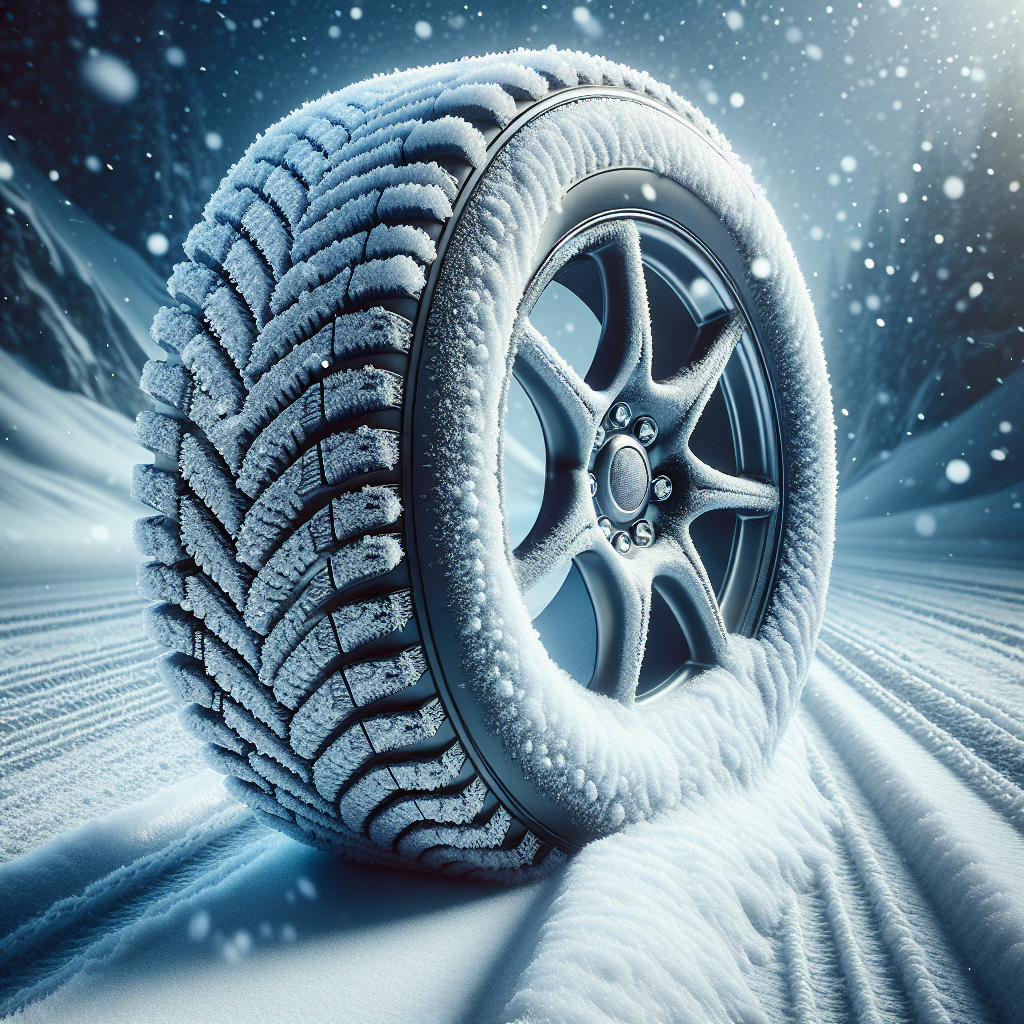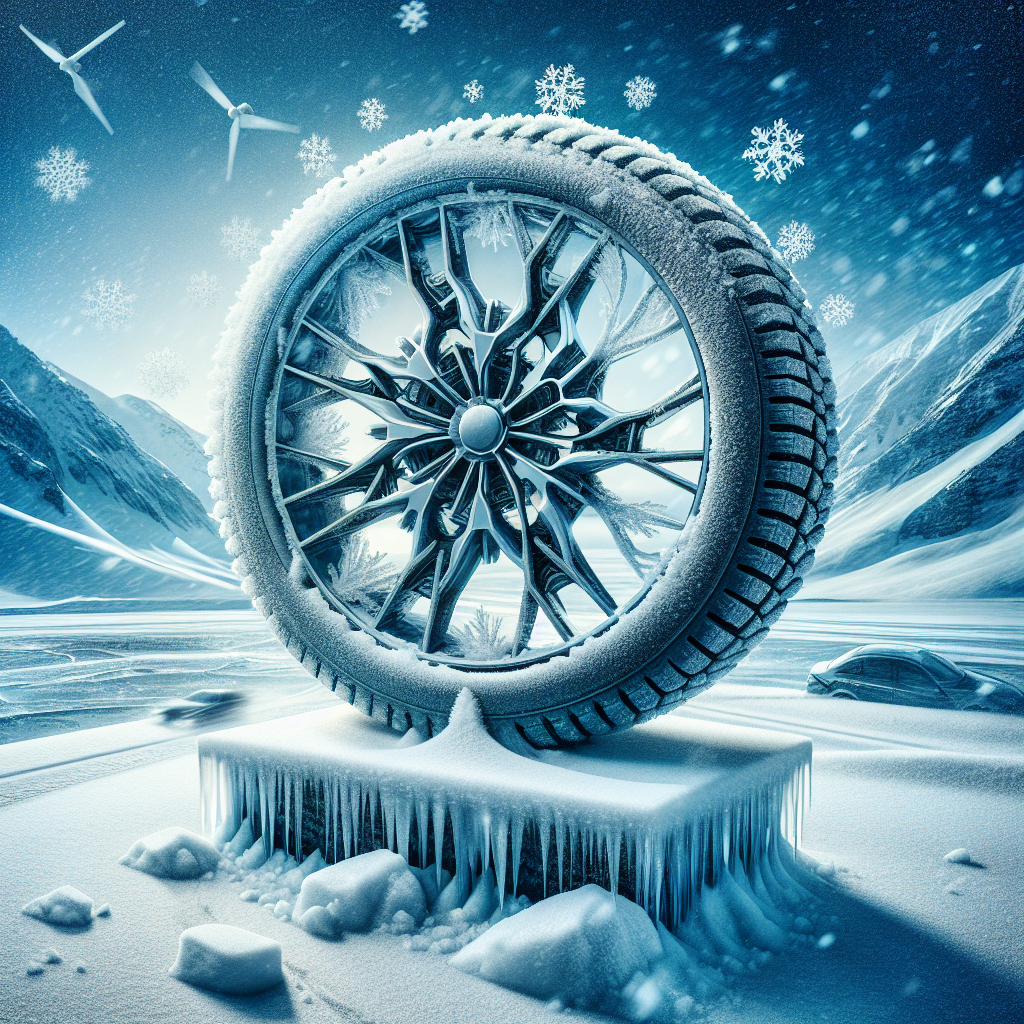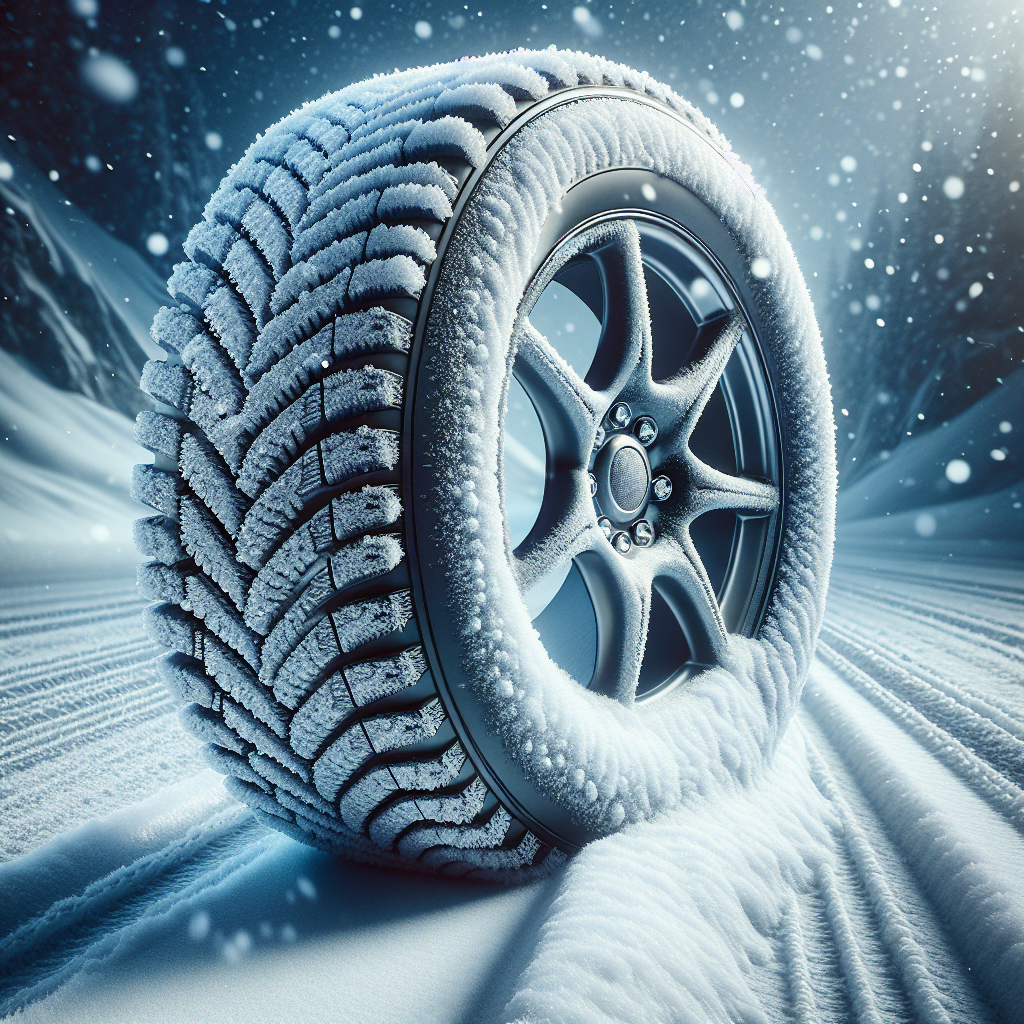Imagine driving down a snow-covered road on a chilly winter morning, hoping that your winter tires will keep you safe and secure. But what happens when that fresh layer of snow has turned into a treacherous mix of snow and ice? Will your winter tires still be able to handle the road conditions effectively? Let’s delve into the world of winter tires and explore how they handle when faced with this challenging situation.

Traction of Winter Tires
The importance of traction in winter driving conditions
When driving in winter conditions, traction is of utmost importance to ensure your safety on the road. Traction refers to the grip between your tires and the surface of the road, and it plays a crucial role in your vehicle’s ability to accelerate, brake, and maneuver effectively. With snow and ice present, the traction levels can be significantly reduced, making it essential to equip your vehicle with winter tires.
How winter tires provide better traction on snow and ice
Winter tires are specifically designed to excel in cold and snowy conditions. They feature a unique rubber compound that remains flexible in low temperatures, allowing the tire to maintain optimal contact with the road surface. Additionally, winter tires have deeper tread depths and unique tread patterns, which work together to bite into the snow and ice, providing enhanced traction. With their specialized construction, winter tires maximize grip and improve your vehicle’s overall performance.
Understanding the different types of winter tire tread patterns
Winter tires come in various tread patterns, each designed to perform optimally in specific winter conditions. One common tread pattern is the “directional” tread, featuring V-shaped grooves that expel snow and slush efficiently. This design reduces the risk of hydroplaning and enhances traction. Another type is the “symmetrical” tread pattern, with its uniform and intricate groove design. This pattern provides excellent grip in snowy conditions and maintains stability on icy surfaces. The “asymmetrical” tread pattern combines the advantages of both directional and symmetrical tread patterns, offering well-balanced performance on various winter surfaces.
Advantages of winter tire tread patterns in mixed snow and ice conditions
When faced with a mix of snow and ice conditions, winter tire tread patterns offer distinct advantages. The directional tread patterns excel at displacing snow and slush, preventing the tire’s contact area from becoming clogged. This ensures consistent traction on both snow and ice surfaces. Symmetrical tread patterns, on the other hand, provide reliable grip in snowy conditions while maintaining stability on icy roads. The combination of various tread elements in asymmetrical tread patterns allows for improved traction on mixed surfaces, enabling you to confidently navigate through diverse winter conditions.
Performance on Snow
The ability of winter tires to grip and navigate through snow
Winter tires are specifically engineered to excel in snowy conditions, allowing them to provide exceptional grip and control. The deeper tread design of winter tires allows them to cut through snow, providing increased traction compared to all-season or summer tires. Furthermore, the specialized rubber compounds in winter tires remain flexible in cold temperatures, enhancing their ability to grip the snow-covered road surface. With winter tires, you can confidently navigate through snow, ensuring efficient acceleration, braking, and maneuverability.
How tread design and depth affect snow performance
The design and depth of the tread play a crucial role in a winter tire’s performance on snow. Winter tires generally feature larger tread blocks with more aggressive patterns. These large tread blocks allow the tire to bite into the snow, providing improved traction. Additionally, the deeper tread depths of winter tires help push snow through the grooves, preventing slippage and maintaining consistent contact between the tire and the road. The combination of an aggressive tread design and deep tread depth ensures optimal snow performance, enabling you to confidently tackle snowy roads.
The role of siping in enhancing snow traction
Siping refers to the small cuts or slits in the tire’s tread blocks, and it plays a significant role in enhancing snow traction. These cuts create additional edges that grip the snow, improving traction and control. Siping allows the tread blocks to better conform to the snowy surface, increasing the tire’s ability to bite into the snow and maintain grip. With the help of siping, winter tires can effectively navigate through various depths of snow, ensuring your safety and performance on snowy roads.
Benefits of specific snow-focused winter tire models
Some winter tire models are specifically engineered to excel in snowy conditions. These snow-focused winter tires are designed with deeper and more aggressive tread patterns, maximizing their snow traction capabilities. They often feature a higher number of sipes, ensuring superior grip on snowy surfaces. Snow-focused winter tire models also incorporate specialized winter rubber compounds, maintaining flexibility even in extremely cold temperatures and enhancing overall snow performance. Choosing snow-focused winter tires will provide you with the confidence and stability you need in challenging snowy conditions.
Handling on Ice
Challenges posed by ice and its impact on tire grip
Ice presents one of the most hazardous conditions for drivers, as it significantly reduces tire grip and control. Ice is essentially a frictionless surface, making it extremely challenging for tires to effectively grip the road. The lack of friction compromises your vehicle’s ability to accelerate, brake, and navigate corners safely. It is crucial to equip your vehicle with winter tires that are specifically designed to overcome these challenges and provide enhanced grip on icy surfaces.
Features of winter tires that improve handling on icy surfaces
Winter tires are equipped with several features that improve handling on icy surfaces. One of these features is the specialized rubber compound used in their construction. Winter tire compounds remain pliable in low temperatures, which allows the tire to conform to the icy surface and effectively grip it. Additionally, winter tires often have micro-pores or “bite edges” in the rubber, which provide additional traction on ice. These features combine to ensure better handling and control on icy surfaces, allowing you to navigate with increased confidence.
Studded vs. studless winter tires in icy conditions
In icy conditions, both studded and studless winter tires offer advantages for enhanced grip. Studless winter tires utilize various tread patterns, siping, and specialized rubber compounds to deliver excellent traction on ice. They rely on the tire’s contact with the ice surface to provide grip. Studded winter tires, on the other hand, feature metal studs embedded in the tread, which further increase traction on icy roads. The metal studs bite into the ice, providing superior grip and stability. However, studded tires may be restricted or prohibited in some areas due to their potential to damage road surfaces. Both studded and studless tires have their merits, so consider your local regulations and personal preferences when choosing the right winter tires for icy conditions.
How tire pressure affects ice performance
Proper tire pressure is critical for optimal performance on ice. Underinflated tires reduce the tire’s contact patch, limiting the amount of rubber that can grip the icy surface. This leads to reduced traction and compromised handling. Conversely, overinflated tires can also hinder ice performance, as they reduce the contact area and may cause the tire to slide more easily. It is important to maintain the recommended tire pressure for your specific winter tires to ensure optimal grip and handling on icy surfaces.
Effectiveness of special ice-focused tire technologies
To further improve ice performance, some winter tires incorporate specialized ice-focused technologies. These technologies include advanced tread designs, additional sipes, and unique rubber compounds specifically engineered for icy conditions. Winter tires with ice-focused technologies aim to optimize the tire’s performance on ice, increasing overall traction and enhancing maneuverability. The effectiveness of these technologies varies across different tire models, so it is essential to research and select a winter tire that prioritizes ice performance if you frequently encounter icy conditions.
Braking and Acceleration
Factors that affect braking and acceleration on snow and ice
Braking and acceleration on snow and ice are affected by several factors, primarily the level of traction between the tires and the road surface. In snow, the depth and density of the snow can influence braking and acceleration performance, as deeper snow creates additional resistance. On ice, the lack of friction reduces the tire’s grip, making it more challenging to stop the vehicle quickly or accelerate efficiently. Additionally, tire condition, tread pattern, and tire pressure all impact braking and acceleration performance in winter conditions.
The impact of winter tire compounds on braking and acceleration
Winter tire compounds play a vital role in improving braking and acceleration performance in winter conditions. The unique rubber compounds used in winter tires remain pliable even in low temperatures, allowing the tire to conform to the road surface and maintain grip. This improved pliability enhances braking capabilities, as it maximizes the tire’s contact patch with the road, facilitating effective stops in snow and ice. Similarly, the flexibility of winter tire compounds enhances acceleration by providing better traction and reducing wheelspin on slippery surfaces.
Advantages of winter tire designs in stopping and starting
Winter tire designs offer several advantages when it comes to stopping and starting in winter conditions. The aggressive tread patterns and deeper grooves of winter tires effectively channel snow and ice away from the tire’s contact patch, allowing for improved traction and reducing the risk of hydroplaning. The large tread blocks and siping in winter tires also provide additional biting edges, increasing grip on snowy and icy surfaces. With their specialized designs, winter tires allow for shorter stopping distances and more controlled acceleration, ensuring your safety and confidence on winter roads.
The role of tire studs in enhancing braking and acceleration
Tire studs are metal pins that are inserted into the tread of some winter tires to provide additional grip on icy surfaces. The studs help to penetrate the icy surface, creating a strong connection between the tire and the road. This increased friction allows for better braking performance and improved acceleration, particularly on ice. However, it is important to note that tire studs may be restricted or prohibited in certain areas due to their potential to damage roads. Consider local regulations and road conditions when deciding whether studded winter tires are suitable for your winter driving needs.

Cornering and Stability
Challenges of cornering and maintaining stability on mixed snow and ice
Cornering and maintaining stability on mixed snow and ice can be particularly challenging due to the varying levels of traction. Snow and ice can create uneven surfaces, reducing tire grip and compromising cornering capabilities. The lack of traction can cause the vehicle to slide or lose control during turns, increasing the risk of accidents. To overcome these challenges, winter tires incorporate specific features that enhance cornering and stability, providing drivers with increased control and confidence.
Winter tire features that enhance cornering and stability
Winter tires are designed to enhance cornering and stability in mixed snow and ice conditions. The tread patterns of winter tires often feature large tread blocks, providing increased stability and control during cornering. These large tread blocks help maintain a consistent grip with the road, reducing the likelihood of sliding or skidding. Additionally, winter tires may have additional sipes or biting edges on the tread blocks, further improving cornering performance. These features enhance the tire’s ability to maintain traction and keep the vehicle stable on mixed winter surfaces.
Effectiveness of different tire technologies in icy corners
In icy corners, certain tire technologies exhibit increased effectiveness and provide superior grip. One such technology is the use of specialized ice compounds in tire construction. These compounds maintain their flexibility in extremely cold temperatures, enhancing grip on icy surfaces and allowing for better cornering performance. Additionally, microscopic pores or “bite edges” on the tire’s rubber provide extra traction and bite into the ice during corners, improving control and stability. By employing these technologies, winter tires are optimized for icy cornering, allowing you to navigate turns with confidence.
The impact of tread block design on cornering performance
Tread block design plays a crucial role in cornering performance on mixed snow and ice. Winter tires often feature larger tread blocks, which provide increased stability and better grip during cornering. The larger blocks offer a larger surface area, increasing the contact between the tire and the road. This enhanced contact ensures better traction and control while navigating corners in winter conditions. Additionally, the arrangement of the tread blocks, along with sipes and biting edges, further amplifies cornering performance, allowing you to maneuver through icy corners with improved stability.
Aquaplaning
The risk of aquaplaning on wet and slushy surfaces
Aquaplaning, also known as hydroplaning, is a significant risk when driving on wet and slushy surfaces. It occurs when a layer of water builds up between the tires and the road, leading to a loss of traction and control. Aquaplaning greatly reduces the tire’s ability to grip the road, making it challenging to control the vehicle’s speed and direction. It is crucial to address this risk and equip your vehicle with winter tires that can effectively combat aquaplaning in mixed snow and ice conditions.
How winter tires reduce the likelihood of aquaplaning
Winter tires offer features that reduce the likelihood of aquaplaning on wet and slushy surfaces. The tread patterns of winter tires are designed to quickly channel water and slush away from the tire’s contact patch, ensuring a continuous grip with the road. The unique groove patterns and wider circumferential grooves in winter tires efficiently disperse water and prevent it from forming a barrier between the tire and the road. By reducing the risk of aquaplaning, winter tires increase your safety and control in wet and slushy conditions.
The role of tire tread patterns in preventing hydroplaning
Tire tread patterns play a crucial role in preventing hydroplaning. The specific tread patterns of winter tires are designed to effectively combat aquaplaning by channeling water away from the tire’s contact patch. The deep and wide grooves between the tread blocks are strategically positioned to evacuate water and slush, creating channels for water dispersion. This allows the tire’s rubber to maintain contact with the road surface, preventing the buildup of water between the tire and the road. By incorporating these tread patterns, winter tires greatly reduce the risk of hydroplaning, ensuring your safety in wet and slushy conditions.
Advantages of winter tires with wide circumferential grooves
Winter tires with wide circumferential grooves provide distinct advantages in preventing aquaplaning. These wide grooves are designed to efficiently channel large volumes of water and slush away from the tire’s contact patch, reducing the risk of aquaplaning. By expelling water from the tread area, wide circumferential grooves allow the tire to maintain contact with the road, ensuring reliable grip and enhanced control. This feature is especially effective in mixed snow and ice conditions, where melting snow and slush can accumulate, posing a high risk of aquaplaning.

Noise and Comfort
The influence of tire tread design on noise levels
Tire tread design can have a significant impact on the noise levels experienced while driving. As tires interact with the road surface, they generate noise due to the friction and vibrations caused by the tread pattern. Winter tires often exhibit more aggressive tread patterns compared to all-season or summer tires, which can contribute to increased noise levels. However, advancements in tire technology have enabled manufacturers to design winter tires with reduced noise levels. It is essential to consider both noise levels and performance when choosing winter tires to ensure a comfortable driving experience.
How winter tires maintain comfort in mixed snow and ice
Despite their more aggressive tread patterns, winter tires are designed to maintain comfort in mixed snow and ice conditions. Winter tire manufacturers prioritize a balance between performance and comfort, utilizing various technologies and materials to achieve a smooth and pleasant driving experience. Advanced tread designs, tread block configurations, and improved rubber compounds help reduce excessive noise and vibrations, ensuring a comfortable ride in winter conditions. By selecting the right winter tires, you can enjoy both enhanced performance and a comfortable driving experience.
Performance trade-offs between comfortable and aggressive winter tires
When choosing winter tires, it is important to consider the performance trade-offs between comfortable and aggressive options. Aggressive winter tires with larger tread blocks and more pronounced patterns often provide enhanced traction and control in extreme winter conditions. However, they may generate more noise and potentially compromise ride comfort compared to less aggressive options. Conversely, winter tires designed with a focus on comfort may sacrifice some performance capabilities. Balancing your preferences for comfort and performance will help you select the winter tires that suit your specific needs and driving conditions.
Longevity and Wear
Factors affecting winter tire longevity in mixed snow and ice
Winter tires are subjected to harsh conditions during winter driving, which can have an impact on their longevity. Several factors contribute to winter tire wear in mixed snow and ice conditions. The abrasiveness of the road surface, exposure to salt and other de-icing chemicals, and frequent temperature fluctuations can accelerate tire wear. Driving habits, such as aggressive acceleration and braking, can also impact tire longevity. It is important to be mindful of these factors and take steps to maximize the lifespan of your winter tires.
Tire compounds and their impact on wear in harsh conditions
The compounds used in winter tire construction significantly impact their durability and wear resistance in harsh conditions. Winter tires are engineered with specialized rubber compounds that remain flexible in cold temperatures, ensuring optimal performance. These compounds are designed to withstand the abrasive nature of winter road surfaces and the exposure to de-icing chemicals. High-quality winter tires often incorporate advanced compounds that offer improved wear resistance, ensuring longevity and reducing the need for frequent replacements.
Tips for maximizing the lifespan of winter tires
To maximize the lifespan of your winter tires in mixed snow and ice conditions, consider the following tips:
- Regular maintenance: Regularly inspect your tires for signs of damage, uneven wear, or punctures. Maintain proper tire pressure and ensure regular wheel alignments and rotations.
- Storage: When not in use, store your winter tires in a cool, dry place away from direct sunlight and extreme temperatures.
- Driving habits: Avoid aggressive acceleration, braking, and cornering, as these can significantly increase tire wear. Opt for smooth and controlled driving techniques.
- Avoid unnecessary driving: Minimize driving on dry or warm pavement, as winter tire compounds are designed for optimal performance in cold temperatures and can wear quickly in warmer conditions.
- Use suitable tires: Ensure you have selected the right tire model and size for your vehicle and driving conditions. Installing the appropriate winter tires will maximize their lifespan and overall performance.

Temperature Sensitivity
The effect of temperature on winter tire performance
Winter tire performance is directly affected by temperature. Winter tires are engineered to remain flexible and provide optimal traction in cold temperatures. As the temperature drops, the rubber compounds of winter tires maintain their pliability, allowing the tire to grip the road surface effectively. However, as temperatures rise above a certain threshold, winter tire compounds can become less pliable, resulting in reduced grip and compromised performance. Understanding the temperature sensitivity of winter tires is vital for selecting the right tires and ensuring safe driving in different weather conditions.
Optimal temperature range for winter tire efficiency
Winter tires are most efficient and effective within a specific temperature range. Generally, winter tires excel in temperatures below 45°F (7°C). As temperatures drop, the rubber compounds of winter tires remain flexible, maximizing traction and grip. However, as temperatures approach freezing or rise above it, the advantages of winter tires diminish. Beyond this optimal temperature range, the rubber compounds may harden, reducing the tire’s ability to conform to the road surface and decreasing traction. It is important to consider temperature fluctuations and select the appropriate tires to ensure optimal efficiency and safety.
Performance limitations of winter tires in extreme cold
While winter tires are engineered to excel in cold temperatures, they do have performance limitations in extreme cold conditions. In extremely cold temperatures, winter tire compounds may become excessively stiff, compromising their ability to maintain grip on the road. The reduced pliability of the rubber can lead to reduced traction and longer stopping distances. Additionally, extreme cold combined with icy surfaces can challenge the effectiveness of winter tire tread patterns, as ice can create a smooth and frictionless surface that is difficult to grip. It is crucial to exercise caution and adjust driving habits accordingly in extremely cold conditions.
Choosing the Right Winter Tires
Factors to consider when selecting winter tires for mixed snow and ice
When selecting winter tires for mixed snow and ice conditions, consider the following factors:
- Tread design: Choose a tread pattern that suits the conditions you will encounter the most, whether it’s a directional, symmetrical, or asymmetrical design.
- Rubber compound: Look for winter tires with specialized rubber compounds that remain flexible in cold temperatures, providing optimal traction.
- Size and fit: Ensure the winter tires you choose are compatible with your vehicle’s specifications, including size, load rating, and speed rating.
- Usage requirements: Consider your typical driving conditions, such as the amount of snow, ice, and slush you encounter, and select winter tires tailored to those conditions.
- Local regulations: Check local regulations regarding studded tires and ensure compliance, if applicable.
- Manufacturer ratings and reviews: Research ratings, reviews, and recommendations from reputable sources to gain insights into the performance of specific winter tire models.
Understanding tire size, load rating, and speed rating
Understanding tire size, load rating, and speed rating is essential when selecting winter tires. Tire size refers to the dimensions of the tire, including width, aspect ratio, and rim diameter. It is crucial to choose winter tires that match the size specifications recommended by your vehicle manufacturer. Load rating indicates the maximum weight each tire can support. It is important to select tires with an appropriate load rating to ensure safety and performance. Speed rating denotes the maximum speed for which the tire is rated. Select winter tires with a speed rating that meets or exceeds your typical driving needs to maintain safety and functionality.
Reviewing winter tire performance tests and ratings
To make an informed decision, it is beneficial to review winter tire performance tests and ratings conducted by reputable organizations. These tests evaluate various aspects of tire performance, including traction, braking, and handling on snow and ice. They also consider factors such as noise levels, comfort, and longevity to provide a comprehensive assessment of each tire model’s capabilities. By reviewing these tests and ratings, you can gain valuable insights into the performance and suitability of different winter tire models for mixed snow and ice conditions, helping you select the best tires for your specific needs.
Importance of matching winter tire performance to driving conditions
Choosing winter tires that match the driving conditions you commonly encounter is of utmost importance. Winter tires are available in a range of models, each designed to excel in specific conditions. Consider the mix of snow and ice you anticipate facing and select tires that prioritize those conditions. For example, if you frequently encounter icy roads, opting for winter tires with enhanced ice grip technologies may be beneficial. By matching the performance characteristics of your winter tires to the prevailing driving conditions, you can ensure optimal traction, control, and safety throughout the winter season.


